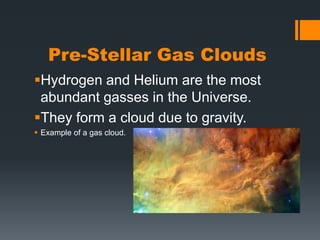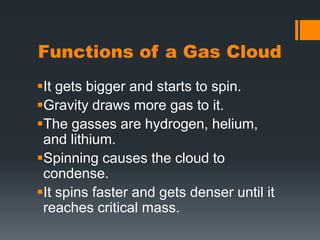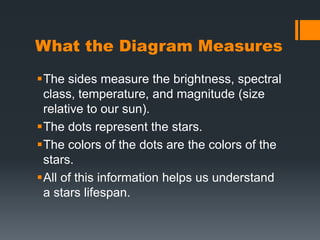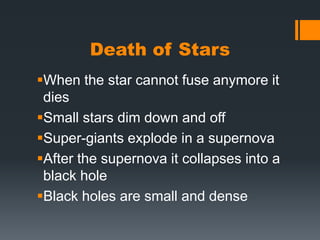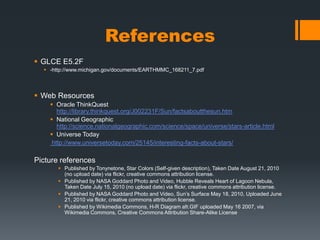How a star is born, lives,
- 1. How a Star is Born, Lives, and DiesMatt Frisco
- 2. Pre-Stellar Gas CloudsHydrogen and Helium are the most abundant gasses in the Universe.They form a cloud due to gravity.Example of a gas cloud.
- 3. Functions of a Gas Cloud It gets bigger and starts to spin.Gravity draws more gas to it.The gasses are hydrogen, helium, and lithium.Spinning causes the cloud to condense.It spins faster and gets denser until it reaches critical mass.
- 4. A Star is BornThe cloud gets smaller, denser, and hotter.Eventually hydrogen begins to fuse.2 hydrogen atoms become 1 helium atom.This process releases light and heat energy.Then the star lights up.
- 5. Early Days of a StarFusion continues in the core where its hottest.The size depends on how much gas was in the cloud.Temperature depends on how much gas is fusing.Bigger hotter stars fuse more.Smaller cooler stars fuse less.
- 6. Classifying StarsStars are many colors, sizes, and temperatures.Characteristics of stars are dependant of each other.For example: Big stars are hotter and bluer.
- 7. Examples of Star ColorStars can have many colorsThe most common are yellow and whiteBlue are biggest and hottestRed and Orange are average
- 8. The Hertzsprung–Russell Diagram The HR Diagram groups stars.The diagram was created in 1910.The diagram tells us everything about stars.All the information helps us understand a stars lifespan.
- 10. What the Diagram MeasuresThe sides measure the brightness, spectral class, temperature, and magnitude (size relative to our sun).The dots represent the stars.The colors of the dots are the colors of the stars.All of this information helps us understand a stars lifespan.
- 11. Types of StarsThe curve shape through the middle are the main sequence stars.The bottom left are white dwarfs.The top right are red giants.The top left are blue super-giants.
- 12. Main Sequence StarsMost stars are currently main sequence.Main sequence stars are many colors and temperatures.Main sequence stars fuse hydrogen and helium and other light gasses.Stars jump in and out of the main sequence.
- 13. Other StarsSome stars live their whole lives off the main sequence.Some jump on and off.Some special stars are blue giants and white dwarfs.Blue giants are big, bright, and hot.White dwarfs are small, dim. and cool.Blue giants don’t live long and white dwarfs live long.
- 14. Lives of StarsStars live for 5 million-10 billion years.Stars turn mass into energy.Stars fuse all elements up to Iron; but not heavier.Stars and nebula make up 98 percent of all matter. Life wouldn’t be possible without stars.Stars are usually at least 3 light years from each other.
- 15. Our StarThe name of the Sun is SolSol is 4.6 billion years old It will live another 5 billion yearsIt takes 8 minutes for light to reach Earth Sol can fit 1million Earths inside of it
- 16. Death of StarsWhen the star cannot fuse anymore it diesSmall stars dim down and offSuper-giants explode in a supernovaAfter the supernova it collapses into a black holeBlack holes are small and dense
- 17. ReferencesGLCE E5.2F-http://www.michigan.gov/documents/EARTHMMC_168211_7.pdfWeb ResourcesOracle ThinkQuesthttp://library.thinkquest.org/J002231F/Sun/factsaboutthesun.htmNational Geographic http://science.nationalgeographic.com/science/space/universe/stars-article.htmlUniverse Today http://www.universetoday.com/25145/interesting-facts-about-stars/Picture referencesPublished by Tonynetone, Star Colors (Self-given description), Taken Date August 21, 2010 (no upload date) via flickr, creative commons attribution license.Published by NASA Goddard Photo and Video, Hubble Reveals Heart of Lagoon Nebula, Taken Date July 15, 2010 (no upload date) via flickr, creative commons attribution license. Published by NASA Goddard Photo and Video, Sun’s Surface May 18, 2010, Uploaded June 21, 2010 via flickr, creative commons attribution license.Published by Wikimedia Commons, H-R Diagram afr.GIF uploaded May 16 2007, via Wikimedia Commons, Creative Commons Attribution Share-Alike License

